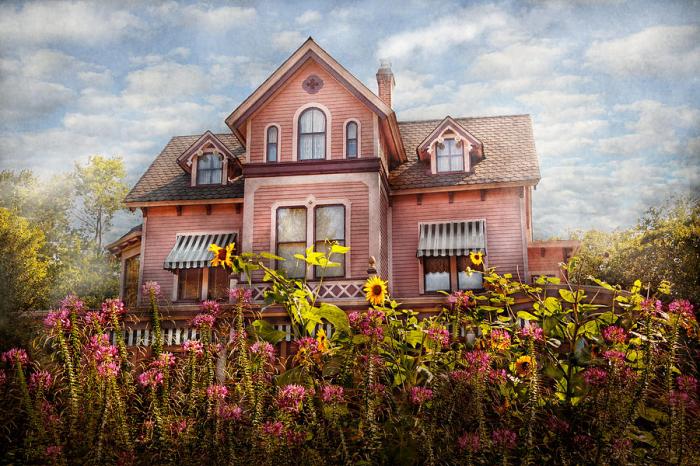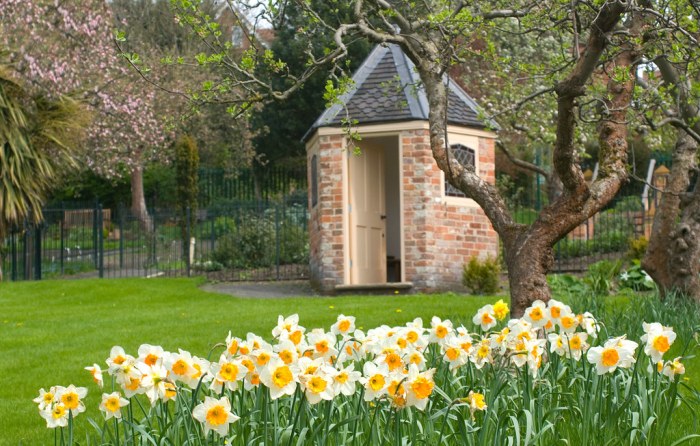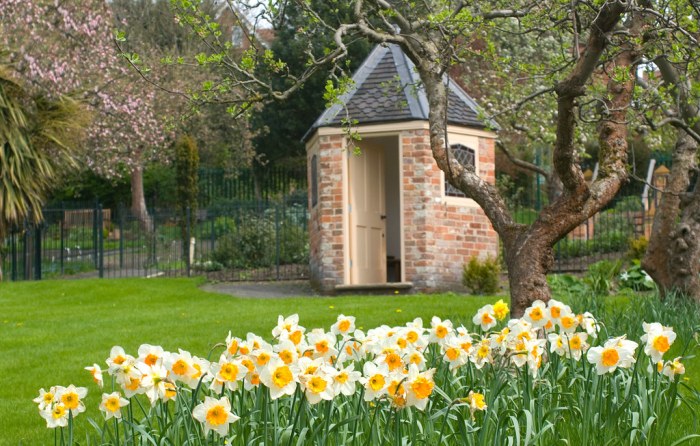Victorian summer houses, with their charming architectural features and idyllic settings, offer a glimpse into the leisure and recreation habits of the Victorian elite. These enchanting structures, often nestled amidst lush gardens, were designed as retreats and gathering places, showcasing the architectural and decorative styles of the time.
From their intricate latticework to their spacious verandas, Victorian summer houses embody the essence of Victorian design. This article delves into the architectural elements, social and cultural significance, and regional variations of these captivating structures, exploring their enduring legacy as cultural heritage and their influence on contemporary architecture.
Victorian Summer House Architecture
Victorian summer houses are distinctive architectural structures designed for leisure and relaxation during the warm summer months. These charming buildings showcase elaborate architectural features, intricate detailing, and a blend of materials that reflect the eclectic tastes of the Victorian era.
Victorian summer houses were typically constructed using a combination of wood, brick, and stone. The exterior walls were often adorned with decorative moldings, fretwork, and gingerbread trim. The roofs were usually steeply pitched and covered with shingles or slate. Many summer houses featured large windows and doors to maximize natural light and ventilation.
Notable Victorian Summer House Designs
Numerous notable Victorian summer house designs have been preserved and continue to inspire architects and designers today. Some of the most iconic examples include:
- The Octagon Housein Newport, Rhode Island: This octagonal-shaped summer house was built in 1862 and features a unique design with eight sides and a central chimney.
- The Bishop’s Palacein Galveston, Texas: This opulent summer home was built in 1892 and is known for its elaborate Victorian architecture and sprawling gardens.
- The Queen Anne Cottagein Cape May, New Jersey: This charming summer cottage was built in 1879 and showcases a classic Queen Anne style with intricate gingerbread trim and a wraparound porch.
Summer House Design Elements: Victorian Summer House
Victorian summer houses were renowned for their ornate and elaborate design elements that reflected the Victorian era’s fascination with aesthetics and intricate craftsmanship. These elements not only enhanced the visual appeal of the houses but also played a functional role in providing shelter and comfort during the summer months.
Verandas
Verandas were a defining feature of Victorian summer houses. These covered porches, often wrapping around the house, provided a sheltered outdoor space for relaxation and entertaining. They were typically supported by decorative columns or brackets and featured intricate latticework or gingerbread trim.
Verandas extended the living space outdoors, allowing occupants to enjoy the fresh air and scenery while remaining protected from the sun and rain.
Bay Windows
Bay windows were another common design element in Victorian summer houses. These projecting windows, typically found in the living room or dining room, provided panoramic views of the surrounding landscape. They were often adorned with stained glass or leaded glass panes, adding a touch of elegance and color to the interior.
Bay windows not only enhanced the aesthetic appeal of the house but also allowed for natural light and ventilation, creating a bright and airy living space.
Intricate Latticework
Intricate latticework was a hallmark of Victorian summer houses. This decorative element was used in various forms, such as fretwork, gingerbread trim, and spindlework. It adorned verandas, gables, and even interior walls, adding a touch of charm and visual interest to the house.
Latticework provided privacy and shade while allowing for air circulation, contributing to the overall comfort and functionality of the summer house.
Landscape and Gardens
Landscaping played a crucial role in Victorian summer houses, serving both aesthetic and functional purposes. The surrounding greenery complemented the architectural style, enhancing the overall ambiance and providing a harmonious transition between the indoors and outdoors.
Victorian summer houses were often situated amidst sprawling gardens, designed to create a picturesque setting. These gardens typically featured a mix of ornamental plants, flowering shrubs, and manicured lawns. The choice of plant species reflected the Victorian fascination with exotic and colorful flora, including roses, hydrangeas, azaleas, and camellias.
Formal Gardens
Formal gardens were a common feature of Victorian summer houses. These gardens were characterized by geometric shapes, symmetry, and carefully arranged flower beds. The paths were often made of gravel or stone, and the borders were defined by low hedges or boxwood.
Informal Gardens
Informal gardens, also known as naturalistic gardens, were designed to mimic natural landscapes. These gardens featured a more relaxed and organic layout, with winding paths, irregular flower beds, and a variety of plant species. They often included ponds, streams, and rock features to create a sense of tranquility and immersion in nature.
Social and Cultural Context
Victorian summer houses were more than just architectural structures; they were symbols of the Victorian era’s leisure and recreation habits. These houses served as retreats and gathering places for the Victorian elite, reflecting the social and cultural values of the time.
Use as Retreats, Victorian summer house
Summer houses provided a sanctuary away from the hustle and bustle of city life. They offered a serene environment for relaxation and contemplation. The Victorians valued leisure time and believed that spending time in nature was essential for physical and mental well-being.
Gathering Places for the Elite
Summer houses were also important social spaces. They were often used for entertaining guests, hosting parties, and engaging in various leisure activities. The Victorians loved to socialize and enjoyed spending time with friends and family in these charming retreats.
Leisure and Recreation Habits
The presence of summer houses underscores the Victorians’ passion for leisure and recreation. These houses facilitated a wide range of activities, such as reading, painting, gardening, and playing outdoor games. The Victorians believed that leisure time should be spent in a meaningful and enjoyable way.
Regional Variations
Victorian summer houses exhibited regional variations influenced by local building traditions and climate. These variations can be seen in the architectural styles, materials used, and decorative elements.
In the United Kingdom, summer houses were typically built using timber framing with brick or stone infill. They featured steeply pitched roofs, often with decorative bargeboards and finials. In the United States, summer houses were often built using clapboard siding and had less elaborate roofs.
In Australia, summer houses were often built using corrugated iron and had wide verandas to provide shade from the sun.
United Kingdom
- Timber framing with brick or stone infill
- Steeply pitched roofs with decorative bargeboards and finials
- Example: The Summer House at Osborne House on the Isle of Wight
United States
- Clapboard siding
- Less elaborate roofs
- Example: The Summer House at Rosecliff in Newport, Rhode Island
Australia
- Corrugated iron
- Wide verandas
- Example: The Summer House at Rippon Lea Estate in Melbourne
Preservation and Restoration
Preserving and restoring Victorian summer houses presents unique challenges due to their age, architectural complexity, and exposure to the elements. Techniques employed include:
- Structural reinforcement: Strengthening beams, joists, and foundations to ensure stability.
- Exterior restoration: Repairing or replacing siding, roofing, and windows to maintain weather resistance.
- Interior conservation: Preserving original finishes, fixtures, and furnishings to retain historical integrity.
Maintaining these structures as cultural heritage is crucial as they embody:
- Architectural innovation: Showcasing the eclecticism and craftsmanship of Victorian architecture.
- Social history: Reflecting the leisure and recreational pursuits of the Victorian era.
- Environmental value: Preserving historic landscapes and enhancing biodiversity.
Notable Preservation Projects
Examples of successful preservation and restoration projects include:
- Asticou Terraces, Maine: A group of six summer cottages restored to their original grandeur, showcasing intricate gingerbread detailing.
- The Breakers, Rhode Island: A grand summer home of the Vanderbilt family, meticulously restored to its former opulence.
- Northover House, Somerset, England: A Grade I listed building, carefully preserved to maintain its architectural integrity and historic gardens.
Contemporary Interpretations
The Victorian summer house style continues to influence contemporary architecture and design, inspiring modern buildings that incorporate its charming and nostalgic elements. These contemporary interpretations adapt the style to modern needs and aesthetics, resulting in a blend of classic and contemporary.
One notable aspect of contemporary interpretations is the use of modern materials and construction techniques. While traditional Victorian summer houses were often built with wood, contemporary versions may incorporate materials such as steel, glass, and concrete. This allows for more durable and energy-efficient structures while maintaining the aesthetic appeal of the Victorian style.
Modern Buildings Incorporating Victorian Elements
- The Glass House by Steven Holl:This modern house in New York’s Hudson Valley features a glass facade that allows for panoramic views of the surrounding landscape, while its gabled roof and decorative trim nod to the Victorian summer house style.
- The Summer House by John Pawson:Located in the Cotswolds, England, this minimalist summer house incorporates Victorian elements such as a gabled roof and bay windows, while its simple and modern design reflects contemporary aesthetics.
- The Victorian Cottage by McAlpine House:This contemporary cottage in Melbourne, Australia, features a traditional Victorian facade with a gabled roof and decorative trim, but its interior is updated with modern amenities and a sleek, open-plan design.
These examples demonstrate how contemporary interpretations of the Victorian summer house style adapt the classic elements to modern needs and aesthetics, creating a blend of nostalgia and innovation.
Interior Design and Furnishings

Victorian summer houses were designed to be comfortable and inviting retreats from the hustle and bustle of everyday life. The interiors were typically light and airy, with a focus on natural materials and soft colors.Light was an important element in Victorian summer house design.
Large windows and doors allowed natural light to flood into the rooms, creating a bright and cheerful atmosphere. The use of light colors, such as white, cream, and pale yellow, further enhanced the sense of spaciousness and airiness.Textiles played a major role in creating a comfortable and inviting atmosphere in Victorian summer houses.
Soft fabrics, such as cotton, linen, and silk, were used for curtains, upholstery, and bedding. These fabrics were often adorned with delicate floral patterns or geometric designs.The furniture in Victorian summer houses was typically simple and functional. It was made from natural materials, such as wood and wicker, and often featured carved or turned details.
Common pieces of furniture included sofas, chairs, tables, and bookcases.Decorative items were used sparingly in Victorian summer houses. A few well-chosen pieces, such as vases, figurines, and paintings, were used to add a touch of personality and style. These items were often inspired by nature, with motifs such as flowers, birds, and animals.
Victorian summer houses, with their intricate designs and charming exteriors, evoke a sense of nostalgia and elegance. They often feature ornate carvings, delicate woodwork, and vibrant colors. In contrast to the lush greenery of a lombok waterfall , these summer houses provide a cozy and shaded retreat amidst the beauty of nature.
Their unique charm makes them a captivating addition to any garden or park, offering a glimpse into the architectural styles of a bygone era.
Historical Anecdotes and Notable Owners

Victorian summer houses have been the backdrop for numerous historical anecdotes and have hosted notable individuals throughout history. These stories and associations have contributed to the cultural significance of these houses, offering glimpses into the lives and times of the people who inhabited them.
One well-known anecdote is associated with the summer house owned by the poet Alfred, Lord Tennyson. It is said that Tennyson would often retreat to his summer house on the Isle of Wight to find inspiration and write poetry. The house became a sanctuary for him, where he could escape the distractions of everyday life and immerse himself in his creative pursuits.
Notable Owners
Many notable individuals have owned or frequented Victorian summer houses. Some of these include:
- Queen Victoria: The monarch who gave the Victorian era its name was a great admirer of summer houses and owned several of them. Her favorite summer house was Osborne House on the Isle of Wight, which she used as a private retreat.
- Prince Albert: Queen Victoria’s husband, Prince Albert, was also a fan of summer houses and designed several of them. His most famous design is the Royal Pavilion at Balmoral Castle in Scotland.
- William Morris: The artist and designer William Morris was a strong advocate for the Arts and Crafts movement and designed several summer houses in this style. His most famous summer house is the Red House in Bexleyheath, Kent.
- Oscar Wilde: The playwright and novelist Oscar Wilde was a frequent guest at summer houses owned by his friends and acquaintances. He often used these houses as a setting for his plays and novels.
The stories and associations with notable individuals have contributed to the cultural significance of Victorian summer houses. They offer a glimpse into the lives and times of the people who inhabited them and provide a tangible connection to the past.
Impact on Tourism and Cultural Heritage
Victorian summer houses play a significant role in promoting tourism and preserving cultural heritage. These charming structures attract visitors from around the world, eager to experience the grandeur and architectural beauty of the Victorian era.
The intricate designs, manicured gardens, and historical significance of these houses make them popular tourist destinations. Visitors can tour the interiors, admire the opulent furnishings, and learn about the lives of the wealthy families who once summered in these opulent retreats.
Contribution to Local Economy
- Summer houses attract tourists, generating revenue for local businesses such as hotels, restaurants, and shops.
- They create employment opportunities in tourism-related industries, including tour guides, museum staff, and hospitality workers.
Preservation and Education
- Preserving and showcasing Victorian summer houses helps to educate the public about Victorian history and architecture.
- They serve as living museums, offering visitors a glimpse into the past and the lifestyle of a bygone era.
Closure
Victorian summer houses stand as testaments to the architectural prowess and leisure pursuits of the Victorian era. Their preservation and restoration ensure that these charming structures continue to grace our landscapes, offering a glimpse into the past and inspiring contemporary design.
Whether as historical landmarks, tourist attractions, or simply as places of respite, Victorian summer houses remain an enduring symbol of architectural beauty and cultural heritage.
FAQs
What materials were commonly used in the construction of Victorian summer houses?
Wood, brick, and stone were the primary materials used, often combined to create visually striking exteriors.
What is the significance of verandas and bay windows in Victorian summer houses?
Verandas and bay windows provided shaded outdoor spaces, extended living areas, and maximized natural light, creating a seamless connection between indoors and outdoors.
How did the surrounding landscape complement the architectural style of Victorian summer houses?
Lush gardens, carefully planned to complement the architectural features, provided a picturesque setting that enhanced the overall aesthetic appeal and created a harmonious relationship between the house and its surroundings.



